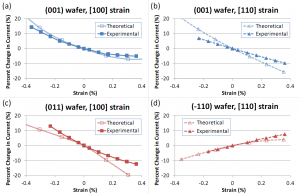Band-to-band Tunneling in Silicon Diodes

Figure 1: Experimental IV plots for tunneling in the [001] direction for 0.13% to 0.39% strain in the [110] direction. The inset depicts the six conduction band lobes for silicon. The relative change in the magnitude of current compared to the unstrained case at 0.7V is quite small for all strains applied: +4.3% change for 0.13% strain and 11.9% change for 0.39% strain.
Band-to-band tunneling is an important phenomenon that can limit off-state leakage in MOSFETs and is also of interest for high-frequency and other novel devices. This work studies the effect of mechanically applied uniaxial strain on reverse-bias band-to-band tunneling current in n+/p+ vertical silicon diodes fabricated on {100} and {110} substrate orientations. The Band Structure Lab [1] and nextnano3 [2] were used to analyze the change in band structure with uniaxial stress applied perpendicular to the tunneling. A theoretical analysis based on the Wentzel-Kramers-Brillouin (WKB) approximation for tunneling probability combined with an uncoupled full-band Poisson equation solver and the calculated band structure changes was developed to model the experimental results.

Figure 2: Comparison of theoretically calculated and experimentally measured relative change in current at 1V reverse bias. (a) Strain applied in [100] direction for [001] tunneling. (b) Strain applied in [110] direction for [001] tunneling. (c) Strain applied in [100] direction for [011] tunneling. (d) Strain applied in [110] direction for [-110] tunneling.
Figure 1 shows the experimental data for a current-voltage (IV) measurement for a range of stresses applied in the [110] direction and tunneling in the [001] direction. The IV shows a nearly ideal thermal regime at sufficiently high forward-bias, a trap limited regime at low forward-bias, and a tunneling regime in reverse-bias. The experimental and theoretical change in current versus strain at 1V reverse-bias for different wafer/strain configurations is plotted in Figure 2. The theoretical calculations for the relative change in tunneling current with strain agree with the behavior of the experimental data. The trend of the change in current with strain is attributed to the change in the energy minimum of the conduction band lobes with strain in combination with the effective tunneling mass of the lobes. Conduction band lobes with a large tunneling mass do not significantly contribute to the tunneling current and play a minor role in the change in current with strain. The strain dependence of the relative change in current is explained by the movement of the energy minimum of the conduction band lobes that have a small tunneling mass.